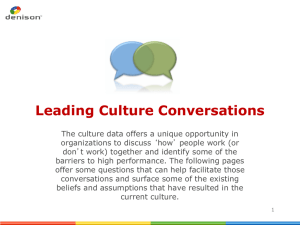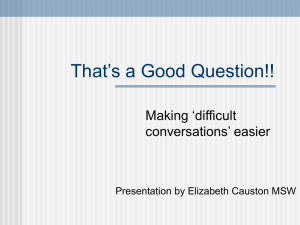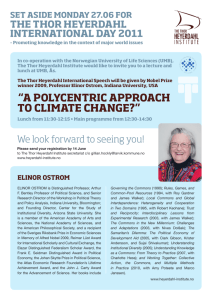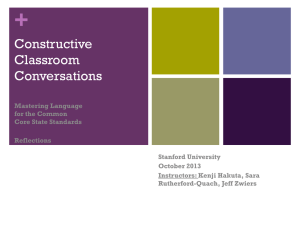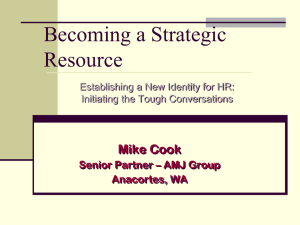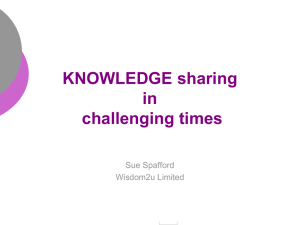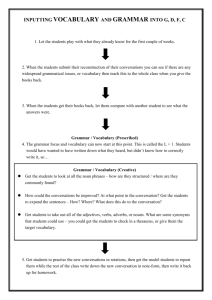TAKING THE COMMUNICATION PERSPECTIVE
advertisement
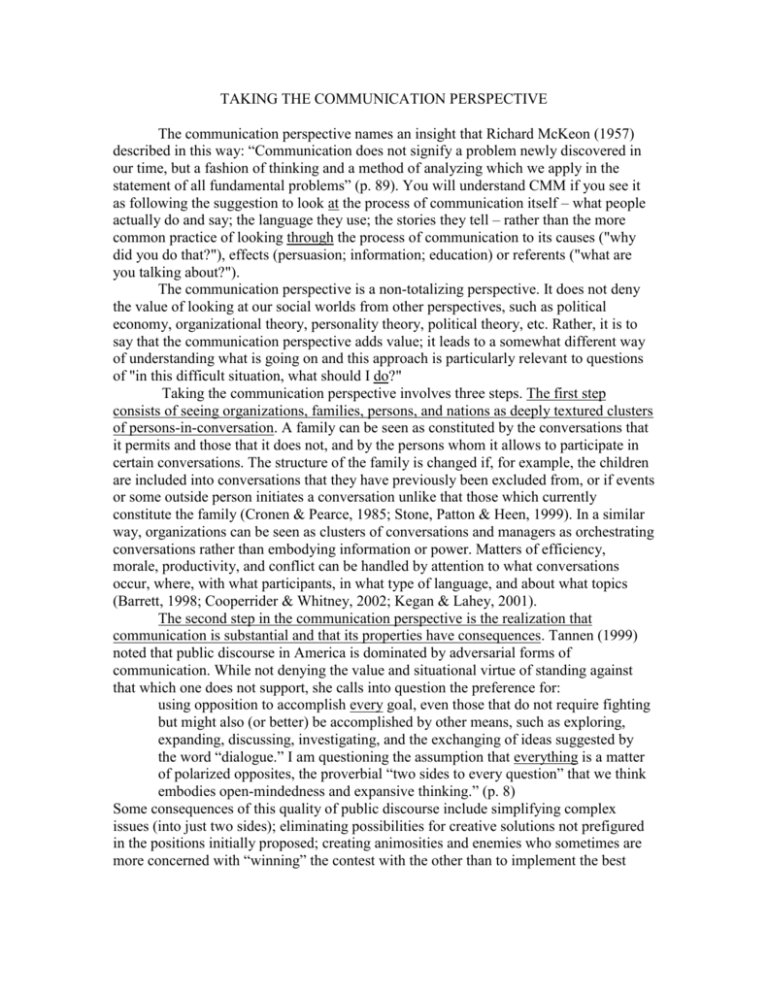
TAKING THE COMMUNICATION PERSPECTIVE The communication perspective names an insight that Richard McKeon (1957) described in this way: “Communication does not signify a problem newly discovered in our time, but a fashion of thinking and a method of analyzing which we apply in the statement of all fundamental problems” (p. 89). You will understand CMM if you see it as following the suggestion to look at the process of communication itself – what people actually do and say; the language they use; the stories they tell – rather than the more common practice of looking through the process of communication to its causes ("why did you do that?"), effects (persuasion; information; education) or referents ("what are you talking about?"). The communication perspective is a non-totalizing perspective. It does not deny the value of looking at our social worlds from other perspectives, such as political economy, organizational theory, personality theory, political theory, etc. Rather, it is to say that the communication perspective adds value; it leads to a somewhat different way of understanding what is going on and this approach is particularly relevant to questions of "in this difficult situation, what should I do?" Taking the communication perspective involves three steps. The first step consists of seeing organizations, families, persons, and nations as deeply textured clusters of persons-in-conversation. A family can be seen as constituted by the conversations that it permits and those that it does not, and by the persons whom it allows to participate in certain conversations. The structure of the family is changed if, for example, the children are included into conversations that they have previously been excluded from, or if events or some outside person initiates a conversation unlike that those which currently constitute the family (Cronen & Pearce, 1985; Stone, Patton & Heen, 1999). In a similar way, organizations can be seen as clusters of conversations and managers as orchestrating conversations rather than embodying information or power. Matters of efficiency, morale, productivity, and conflict can be handled by attention to what conversations occur, where, with what participants, in what type of language, and about what topics (Barrett, 1998; Cooperrider & Whitney, 2002; Kegan & Lahey, 2001). The second step in the communication perspective is the realization that communication is substantial and that its properties have consequences. Tannen (1999) noted that public discourse in America is dominated by adversarial forms of communication. While not denying the value and situational virtue of standing against that which one does not support, she calls into question the preference for: using opposition to accomplish every goal, even those that do not require fighting but might also (or better) be accomplished by other means, such as exploring, expanding, discussing, investigating, and the exchanging of ideas suggested by the word “dialogue.” I am questioning the assumption that everything is a matter of polarized opposites, the proverbial “two sides to every question” that we think embodies open-mindedness and expansive thinking.” (p. 8) Some consequences of this quality of public discourse include simplifying complex issues (into just two sides); eliminating possibilities for creative solutions not prefigured in the positions initially proposed; creating animosities and enemies who sometimes are more concerned with “winning” the contest with the other than to implement the best policies; and driving from the public sphere those who do not relish no-holds-barred combat. Communication is not a neutral vehicle by which an external reality is communicated about, and by which factors of psychology, social structure, cultural norms, and the like are transmitted or are influential. The communication process: (a) exerts a role in the personal identities and self-concepts experienced by persons; (b) shapes the range of permissible and impermissible relationships between persons, and so produces a social structure; and (c) represents the process through which cultural values, beliefs, goals, and the like are formulated and lived. (Sigman, 1995, p. 2) Because communication is both material and consequential, rather than ask, “what is it about?” we ought at least also to ask, “how is it possible for a turn of phrase (or other behavior) to emerge during interaction and to shape, in an unplanned-for manner, ensuing behavioral production?” (Sigman, 1995, p. 4). The third step in the communication perspective consists of treating such things as beliefs, personalities, attitudes, power relationships, and social and economic structures as made, not found. From this perspective, they are seen as constituted in patterns of reciprocated communicative action (Pearce, 1989, pp. 3-31). The term “constituted” stands in the place of other verbs that connote different and, we believe, less useful concepts -- forms of the verb “to be,” for instance, describe things as static and direct our attention to what they are made of and to their causes or effects. On the other hand, the term “constitute” directs our attention to how the events and objects of our social world are made. For example, many people had asked what the carved stone heads on Easter Island meant, and suggested that they were evidence of Egyptian seafarers or monuments to aliens from space. At least as described in his own account of the events, Thor Heyerdahl (1960) employed a different method that generated very different results. He asked a native of the island if he could make one of the megalithic statues. When told that he could, Heyerdahl hired him to do so and filmed the process from beginning to end. Not only a clever way of outflanking interminable arguments among armchair pundits, what we like to call the “Heyerdahl solution” involves a major philosophical shift: describing the processes by which things are made rather than analyzing the final product. Penman's (2000) description of the evolution of her thinking about her work is a wonderful description of moving toward the communication perspective. I first began …with a seemingly innocent and obvious question: “What makes a good relationship?” It soon became apparent, at least to me, that this question needed to be reworded to “What makes a good communication process?” Communication is the observable practice of a relationship, and so it was to the actual process of communicating that I had to attend.” (p. 1) In many ways, the “communication perspective” simply consists of applying the “Heyerdahl Solution” to such things as arguments, political policies, and interpersonal relationships. Like Heyerdahl, we shift from asking about what they “are” and begin to look at how they are “made” (Pearce, 1994, pp. 66-70). One way of working with the communication perspective is to ask three questions: Starting with what we are doing: What are we making together? Starting with an event or object in our social worlds: o How is it made, and being continuously re-made in our patterns of communication? o How can we make better social worlds?
